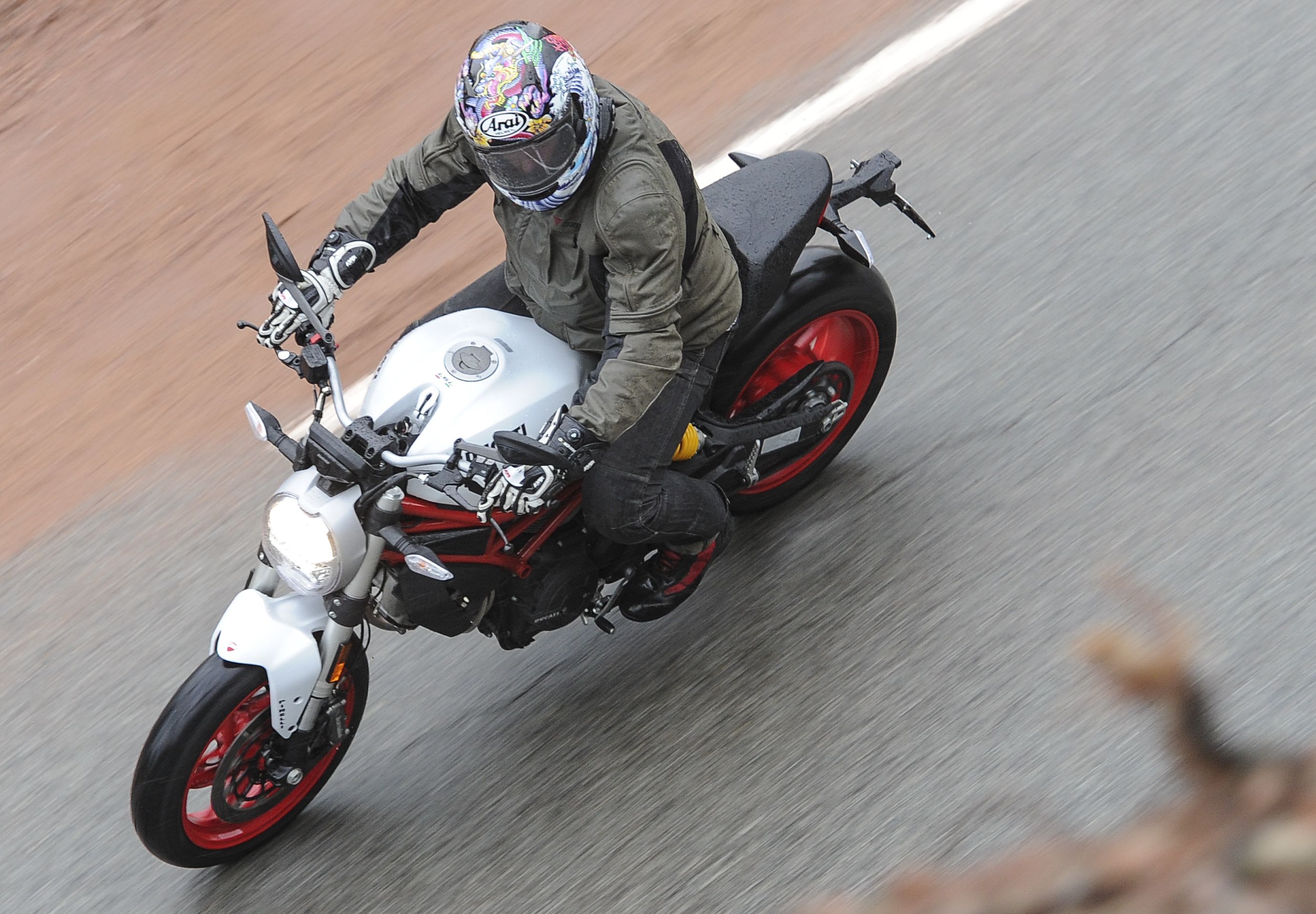How slow should I go in the wet?
Modern motorcycle tires do a remarkable thing in the wet - they work. So how should your riding change when the weather gets soggy?

Monster 797 - I'm soaked and I'm lovin' every minute
Three Steps to Better Rain Riding
Ride for grip. Choose your road position and line base on grip. Pick out weather hazards like manhole covers, then move your vision. If you keep looking at a hazard, you'll run right over it.
Relax. It's easy to tense up in dodgy conditions, you can't turn your neck far enough to look properly and tense arms and shoulders will make steering inputs clumsy.
Enjoy. Wet roads have roughly 30 percent less grip than dry ones - significant, but not drastic. On modern sport-touring tires you can enjoy a ride in the wet. Ice roads are different.
How to relax and maybe even enjoy riding in the rain
One of the things to look for when it's wet is stone content in the pavement. It's the stones in the road that give the grip, not the tar that holds that holds the stones in place. You need to avoid parts that have been polished by traffic. That's probably the biggest difference for me when it's wet. I'm actively searching out the best bit of road to ride on.
On a dry day with a roads surface like sandpaper, I'll ride on the perfect line for view, using as much of the road as possible to see through the corner, then creating an apex when I can see the exit. But on a wet road, I compromise that line because my speed will have dropped of, so I probably don't need as much vision, but I do need better grip. And that will probably mean riding somewhere slightly different (on the road) to avoid low grip areas. You need to be able to stop the bike within your vision, and in the wet, that might be easier to do if you're riding on a grippier patch of road than if you have slightly more vision.
It's the same principle with hazards.
Around roundabouts, for example, you're looking for the line that keeps you the most upright because there's probably loads of oil and diesel and you don't want to be leaned over. And avoiding manhole covers and white lines is important too.
You need to see these in the early stages of your scan, make a plan to avoid them and then not look at them again. It's so easy to think 'Jeez, look how shiny that is' and stare at it and ride right over it.
How do you 'feel' for grip in the wet? It's very difficult. You're looking for feedback, which is what makes the difference between a nice set of tires and an ordinary set. You usually get a feeling of slight uneasiness, sometimes a mild floating sensation, as you approach the limit. It's really the sort of thing you should only learn on track because at least if you go over the limit you probably won't hurt yourself. Even then it's something to experiment with gently.
But most people are overcautious in the wet.
I have to measure the co-efficient of friction (COF) on roads as part of the job of crash investigator, and on a good dry road we would expect a COF of around 0.7 (this is a ratio of how much sideways force is required to move a block compared to its weight). If the road is wet, the COF would be about 0.5. If the road is icy about 0.1.
Now, 0.7 to 0.5 is not a huge drop-off (under 30%), but if you were to look at riders' percentage speed reduction it's much greater than that. People seem to be flick a switch and suddenly ride very slowly not exploiting any grip at all. Also when I'm following someone as the conditions deteriorate I often see tension build in their shoulders, then they get locked elbows. That tells me all I need to know - things are going to get worse.
You have to be relaxed.
When you tense, it doesn't work. I tell people to flap their arms like a duck and if hey can't they're tense. If they just relaxed and trusted their tires, they might even enjoy the wet.
Riding instruction by Gary Baldwin, Director of Rapid Training; he is a crash investigator and ex-racer living in the UK.
You must be logged in to comment
Login now
Any additional comments on road friction in "first rain" vs. time after prolonged rain?
People are often surprised that I show up for work on my motorcycle in the rain. But I live on the west coast of Canada, and if I didn't ride in the rain, I'd only be riding three months of the year instead of most days (reduced in Nov-Feb, but I've ridden in every month). This was helpful. I find myself tensing up, and I have to consciously try to relax.